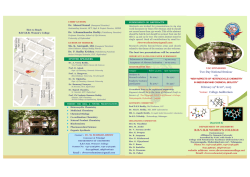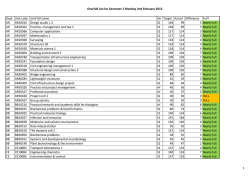
Alvarez-Tostado, Claudio - Stanford Historical Society
MEMORIAL RESOLUTION CLAUDIO ALVAREZ-TOSTADO (1912-1980) Claudio Alvarez-Tostado, Emeritus Professor of Chemistry and Physical Sciences, died in Tucson, Arizona on December 16, 1980, after a relatively brief illness. Tostado was born on June 4, 1912, in Durango, Mexico. His family left Mexico during his youth and settled in Nogales, Arizona. His early education at a Catholic school in Mexico was continued in Nogales, to which place the school, the Escuela Apostolica, also moved because of political pressures. He received his B.S. and M.S. degrees from the University of Arizona, and he came to Stanford in 1935 for doctoral studies under the late Professor J. W. McBain, receiving the Ph.D. degree in 1939. Tostado's doctoral research was concerned with the marked changes in the composition of the serum proteins of the new-born calf, and involved much labor in the separation and characterization of proteins, using the time-consuming methods of that time. More than twenty years later he was invited to serve as Visiting Research Fellow at the Biological Institute of Stockholm, where he developed methods for separating horse serum proteins. He maintained an interest in protein chemistry all his life, and was particularly interested in instrumentation for the characterization of proteins, but his later researches were mainly in inorganic chemistry. He was unusual among chemists of his own or later generations in possessing a deep and well-informed knowledge of electronics. That interest showed itself, on the one hand, in his early practical concern with the high fidelity reproduction of recorded music—a hobby which occupied a good deal of his leisure hours—and, on the other hand, in the rich contributions that he made to his colleagues in the Department of Chemistry through his help in designing and building electronic equipment for use in chemical analysis and related fields. For a number of years he taught a course in Electronic Aids in Research which was of great value to both undergraduate and graduate students, as well as to his colleagues. From 1941 to 1944 Tostado was Assistant Professor of Chemistry at the University of Santa Clara; in 1943-44 he was Lecturer in Chemistry, and from 1944 to 1946 Acting Assistant Professor of Chemistry, at Stanford. In 1946 he began what was to be his major work at Stanford, teaching in the Physical Sciences Program, where he rose to the rank of Professor in 1958 (holding that rank in both Physical Sciences and Chemistry). From 1972 until his retirement in 1977 he was Chairman of the Physical Sciences Program. He will be long and gratefully remembered by many students who profited from his skilled, patient, generous, but demanding teaching. To say that Tostado was devoted to general undergraduate education is to render flatly and colorlessly what for him was a passion. He was himself broadly educated, with that sound, basically classical, Catholic education that the Church so notably provided in many instances. He was a talented linguist, a keen musician with very broad interests, a critical student of both English and Spanish literature, and a manually gifted person to whom the fabrication of a physical object - whether it be a kite or a piece of scientific apparatus - was ever a welcome challenge. His broad interests, soundly rooted in scholarship, took on a practical shape in a long teaching career to which he gladly sacrificed, for the benefit of his students, much of the time that he might otherwise have devoted to his personal research work. Just as he believed that scientists were better scientists for having had a wide exposure to the humanities and social sciences, he believed equally that non-science students should be exposed to a serious, but not highly mathematical, set of courses in chemistry, physics, geology, and astronomy. The Physical Sciences Program was never a full-fledged department at Stanford. It was administered by a small faculty committee with which, at various times, Professors K. Krauskopf, R. A. Walker, J. L. Gibbs, Jr., and H. Katchadourian were associated. The Physical Sciences Program was a degree-granting program, and regularly awarded bachelor's and master's degrees to a steady but relatively small number of majors; its principal value, however, was the contribution that it made to the general education of large numbers of Stanford students, since it had a major place in meeting the physical science requirement of the General Studies Program. Tostado's interests in electronics being as serious as they were, it was natural that, in the early days of solid state devices, he should turn his attention to chemical problems associated with the chemistry of pure silicon. He became much interested in vapor-phase reactions of silicon compounds; and his studies of the reactions of silicon monoxide added significant knowledge and technology to the chemistry of silicon devices, for which he held several patents. In this connection he served as a consultant to a number of companies. As a teacher of science who was at the same time linguistically gifted, Tostado was much in demand as a visiting professor. He turned down many requests to serve overseas under the auspices of the Fulbright and related programs, but he spent a very useful, though occasionally hazardous, year in 1956 at the Universidad de San Andreas and the Military College of Engineering in La Paz, Bolivia. That academic service resulted in his being awarded a Professorship Honoris Causa and an honorary degree from the College of Engineering. In 196566 he contributed very valuable advice and teaching skill to the Universidad Javeriana in Bogota, Columbia, which also named him Professor Honoris Causa. From 1973 to 1976 Tostado directed the Public Affairs Fellowship Program at Stanford. That program, begun under the auspices of the Ford Foundation and the National Institute of Public Affairs, annually sent about fifteen mid-career civil servants to Stanford, as well as to a number of other universities, for a year's full-time study; and Tostado's wide-ranging scholarly talents in fields other than science were very productively used in teaching a core seminar and directing the studies of the Public Affairs Fellows. Those wide-ranging scholarly talents were also called on by the Encyclopedia Britannica, for which he served as a consultant. Except for the periods during which he taught in Bolivia and Columbia, Tostado was rarely away from the campus. But in 1951-52 he spent a year at Harvard as a Fellow of the Fund for the Advancement of Science, a period which was very productive for him and led to a lasting friendship with Gerald Holton, of Harvard's General Education Program. No portrait of Tostado, however brief, would be complete if it failed to point out that he was a strong, theologically literate churchman. He was raised in the Catholic faith and remained faithful to it all his days. He numbered among his close friends many of the faculty of St. Patrick's Seminary in Menlo Park. Tostado was a friendly man. He was selective in forming friendships, but, once made, those friendships commanded his abiding loyalty. He was always ready to provide wise counsel, support, and encouragement to his friends and colleagues. His extraordinary range of skills and interests ensured for him a wide spectrum of friends, for whom it was a great sorrow that, on retirement, he decided to move to Nogales, Arizona. There his abilities as a gardener were severely tested in making a beautiful garden in a rather unfriendly soil and a trying climate, but, with his usual combination of hard work and scientific ingenuity, he fully succeeded. Claudio Tostado leaves a widow, Vee Holt Tostado, herself a Stanford Ph.D. in Clinical Psychology, to whom we extend our deepest sympathy. For Tostado's life, his friendship, and for his great contributions to undergraduate teaching at Stanford we express our gratitude. Eric Hutchinson, Chairman William A. Bonner Robert A. Walker
© Copyright 2025
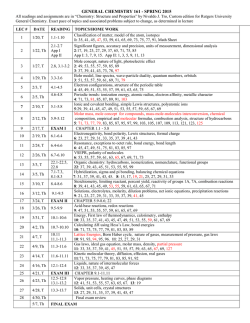
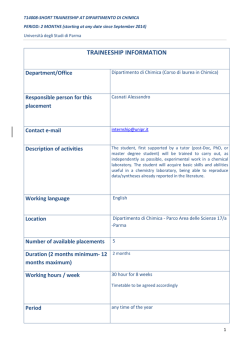
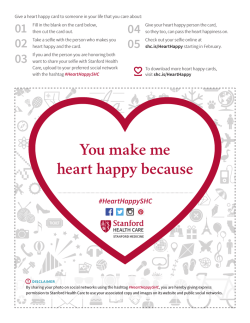
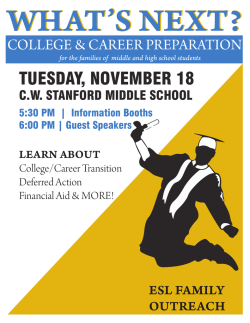
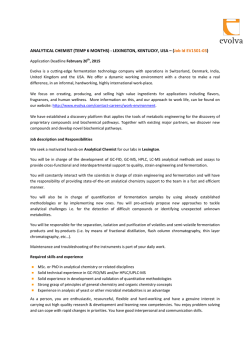
![TIME TABLE MARCH-APRIL 2015 V I III[IMP/BL]](http://s2.esdocs.com/store/data/000483508_1-7e40507e02bf7111da7196362309b7b4-250x500.png)
